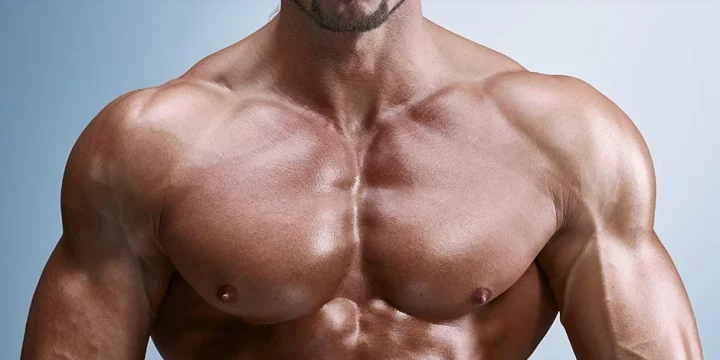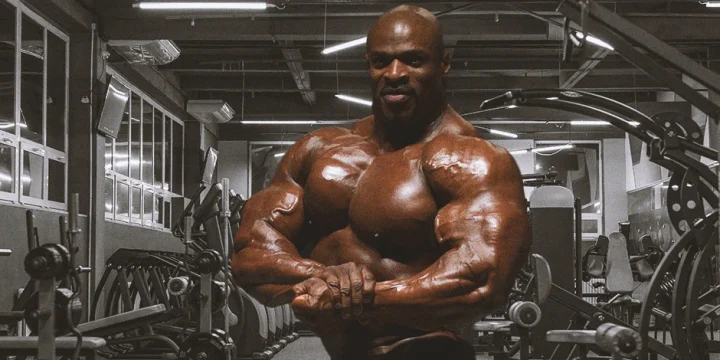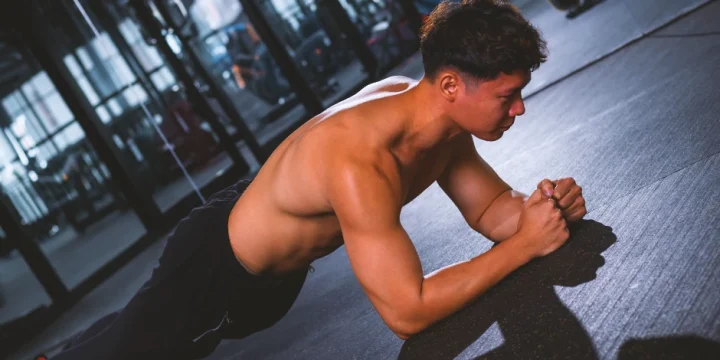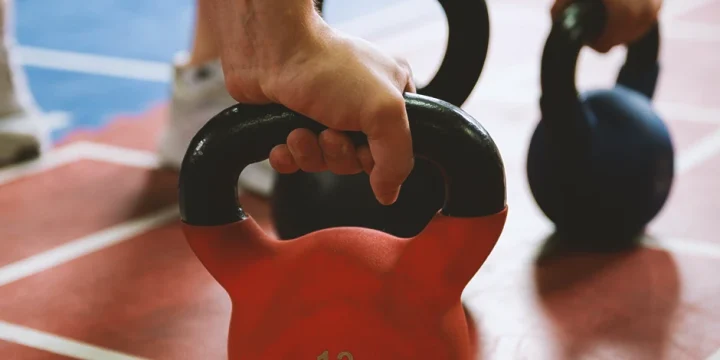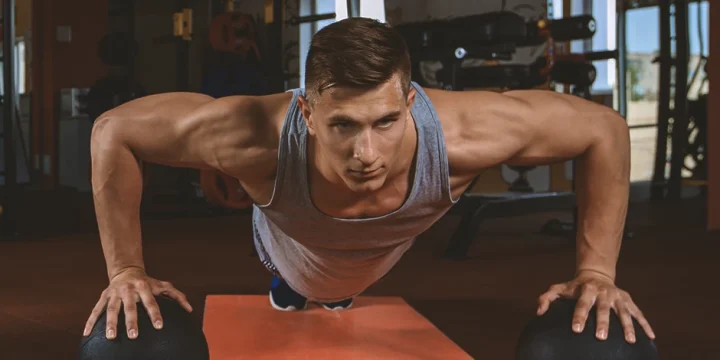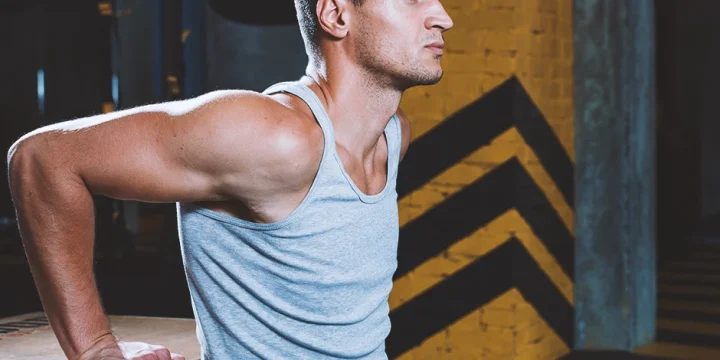Combining specific muscle groups into a single workout enhances the effectiveness of your training and saves time.
After extensive research and practical application, I’ve identified the most effective workout that combines chest and shoulder exercises.
These shoulder and chest exercises are not only backed by scientific research but have also been proven effective by countless athletes and fitness enthusiasts.
Let’s get started.
Quick Summary
- The best chest and shoulder workout focuses on exercises like the seated dumbbell shoulder press, incline dumbbell squeeze press, and cable crossover for muscle growth.
- This workout includes various exercises targeting the pectoral muscles, deltoids, serratus anterior, and rotator cuff muscles, each enhancing specific aspects of upper body strength.
- According to the National Library of Medicine, the chest and shoulder muscles collaborate to execute a broad spectrum of movements, underlining their interconnected role in various physical activities.
- In my opinion, a well-structured chest and shoulder workout routine not only enhances physical appearance but also contributes to a sense of achievement and confidence, making it a rewarding endeavor for fitness enthusiasts.
The Ultimate Chest and Shoulder Workout for Muscle Growth

Here are the best chest and shoulder exercises that have been extensively researched and proven to be highly beneficial in achieving a stronger, more defined upper body. In my years as a coach, I've refined this chest and shoulder workout to maximize muscle growth, combining scientifically-backed exercises with real-world results.
Combining chest and shoulder exercises in a single workout offers several benefits, such as optimized muscle recovery and balanced development. This approach ensures these complementary muscle groups work in synergy, maximizing the efficiency of your training sessions.
Starting your chest and shoulder workout with a proper warm-up routine can significantly reduce the risk of injury and improve your performance. Incorporating dynamic stretches and light cardio activities prepares your muscles and joints for the intense workout ahead.
1. Seated Dumbbell Shoulder Press
This exercise involves lifting weights, either dumbbells or a barbell, above the head to strengthen the shoulder muscles.
To perform a seated shoulder press:
- Adjust the incline bench to 90 degrees.
- Sit on the bench, hold the dumbbells with a neutral grip, and position them on your knees.
- Rotate your palms to face forward.
- Inhale deeply and press the dumbbells overhead.
- Contract your deltoids and extend your elbows.
- Lower the dumbbells slowly to the starting position, keeping your arms at a 90-degree angle.
- Repeat for reps.
2. Incline Dumbbell Squeeze Press
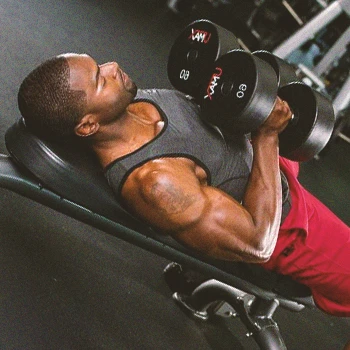
The narrow-grip incline dumbbell bench press differs from the traditional bench press with its grip. This increases the activation of the inner chest muscles.
In my coaching experience, the incline dumbbell squeeze press uniquely activates the inner chest, a game-changer for my clients seeking defined pectorals.
Follow these steps to perform an incline dumbbell squeeze press:
- Adjust the incline bench to 30–45 degrees.
- Pick up two dumbbells with your palms facing inward.
- Lean back onto the bench and bring the dumbbells up to your chest.
- Squeeze the dumbbells together as hard as you can.
- Push the dumbbells up, extending your arms fully and continuing to squeeze them together. Retract your shoulders to arch your spine and exhale.
- Slowly lower the dumbbells back down to your chest while still squeezing them together.
- Repeat for reps.
3. Flat Barbell Bench Press
When it comes to building chest strength and muscle mass, the flat barbell bench press is an excellent exercise with a great carryover effect on sports and everyday activities.
Here are the steps to perform a barbell flat bench press:
- Lie on the flat bench and position your hands just outside shoulder width.
- Pinch your shoulder blades together and push them into the bench.
- Breathe deeply and have a spotter help with the lift off the barbell to maintain upper back tightness.
- Let the weight settle and maintain tightness.
- Lower the bar by unlocking the elbows and inhaling.
- Touch the barbell to your chest and push it back up in a straight line.
- Use leg drive by pushing your feet into the floor and then extending your elbows.
- Repeat for reps.
4. Dumbbell Incline Bench Press
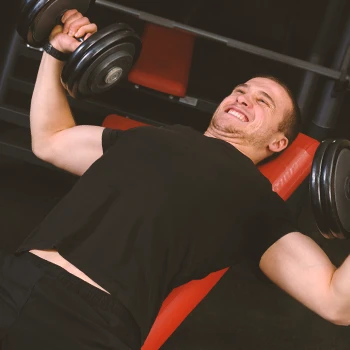
The incline dumbbell bench press targets the upper chest and promotes balanced strength.
Having personally incorporated the incline dumbbell bench press in my routines, I've seen a noticeable improvement in upper chest strength and balance.
Here’s how to do an incline dumbbell bench press:
- Sit on a bench and hold a dumbbell in each hand at shoulder level with your elbows angled down.
- Press both dumbbells over your chest while exhaling, keeping your arms straight.
- At the top, the dumbbells should almost touch, and your arms should be perpendicular to the floor.
- Lower dumbbells slowly to the top of your chest while inhaling.
- Elbows should come down at a 45-degree angle to the torso, not splayed out to the sides.
5. Cable Machine Lateral Raise
Cable lateral raises focus on the lateral head of the deltoid, which is responsible for the round appearance of the shoulders.
Follow these steps to perform this move:
- Attach a handle to the lowest pulley of the cable machine.
- Stand to the side of the machine and grasp the handle with one hand, using an overhand grip.
- Use your other hand to hold onto the tower for support.
- With your elbow slightly bent, lift your arm out to the side until your elbow is at shoulder height.
- Lower your arm slowly to the starting position.
- Repeat for reps.
Related posts:
6. Dumbbell Chest Fly
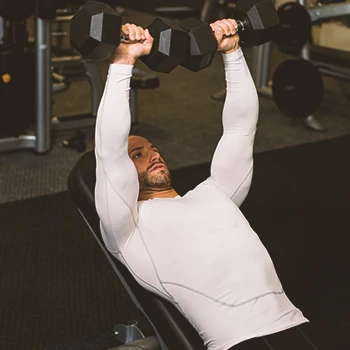
The dumbbell fly is known to increase the width of your chest by focusing on the outer region of the pectoralis major muscle.
From my experience, the dumbbell chest fly effectively widens the chest, making it a staple in my clients' workouts for pectoral development.
To perform a dumbbell chest fly:
- Lie on your back on an incline bench with your feet firmly on the ground.
- Have a spotter hand you two dumbbells, or pick them up by yourself from the floor.
- Extend your arms above your head with palms facing each other until your elbows are at shoulder height.
- Lower the dumbbells in an arc motion to chest level while inhaling.
- Press the dumbbells back up in the same arc motion while exhaling.
- Repeat for reps.
Related: 20 Chest Exercises for Muscle Building
7. Chest Dips
This is one of many staple chest movements that target your pectoral muscles, triceps, and shoulders, resulting in a more substantial and robust upper body appearance.
Follow these steps to perform chest dips:
- Hold the dip bar handles and push up with straight arms.
- Squeeze your shoulder blades and lean forward slightly.
- Cross your feet behind you and bend your elbows toward your lower body, flaring the elbows out.
- Begin the dip by unlocking your elbows and gradually lowering your body until your forearms are nearly parallel to the floor.
- Lower yourself under control until you reach parallel.
- Push yourself back up to the starting position.
- Repeat for reps.
Related: Dips vs Bench Press - Which Is The Better Chest Exercise
8. Bent-Over Rear Delt Raise
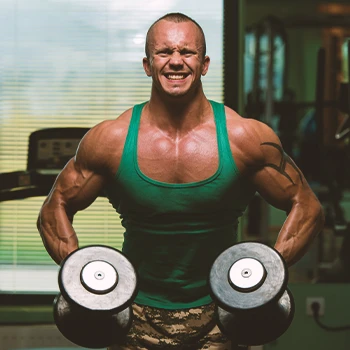
The bent-over rear delt raise is a weight-training upper body exercise that concentrates on developing the back and shoulder muscles, specifically the rear deltoids.
The bent-over rear delt raise has been a key exercise in my training, especially for enhancing the definition of my clients' rear deltoids.
Here’s how to perform this exercise:
- Hold a pair of dumbbells and brace your core.
- Slightly bend your knees and hinge forward from the hips, keeping your back flat.
- Keep your elbows slightly bent and lift the dumbbells out to the side, focusing on your rear shoulders.
- Pause at the top and slowly lower the dumbbells back to the starting position.
9. Arnold Press
The Arnold press is a compound exercise that targets the deltoids, triceps, and upper chest muscle groups. It’s ideal for improving shoulder size and strength.
The steps to perform an Arnold press are as follows:
- Sit on a bench with dumbbells held in front of you, palms facing your shoulders.
- Push the dumbbells up over your head.
- Rotate your arms until your palms face away from you.
- Straighten your arms, pause, and then reverse the movement.
- Repeat for reps.
10. Cable Crossover
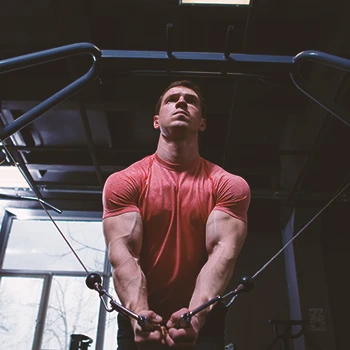
Cable crossovers are generally performed at the end of a chest workout routine, following other more intensive exercises like bench presses, incline presses, and flys.
I often recommend finishing chest routines with cable crossovers, as I've found they provide a strong, satisfying finish to upper body workouts.
To perform a cable crossover, follow these steps:
- Set the pulleys at the highest level and stand in the center with your feet shoulder-width apart.
- Slightly bend your torso and elbows, keeping a neutral spine and straight back.
- Pull both handles down and across your body, engaging your core.
- Hold in the fully contracted position, squeezing your chest muscles.
- Slowly return to the starting position.
Chest and Shoulder Anatomy

Understanding chest and shoulder anatomy is crucial, and I've seen firsthand how this knowledge benefits my clients by improving their exercise technique and effectiveness.
The chest and shoulder muscles work together to perform a wide range of movements, according to the National Library of Medicine [1].
These include the following:
- Pectoralis major: This is the largest muscle in the chest and helps flex and adduct the arm. It consists of two parts: the clavicular head and the sternal head.
- Anterior deltoid: The anterior deltoid is the front of the shoulder, responsible for forward flexion, internal rotation, and horizontal adduction needed for bench press.
- Lateral deltoid: The lateral delts, located on the side of your shoulders, allow for arm abduction and flexion up and down.
- Posterior deltoid: The back fibers of the deltoid muscle, also known as the rear delts, help in extending and rotating the arm outward.
- Serratus anterior: This muscle, located on the side of the chest, stabilizes the scapula during arm movements.
- Rotator cuff: A rotator cuff is a group of four muscles (supraspinatus, infraspinatus, teres minor, and subscapularis) that work together to stabilize the shoulder joint during arm movements and rotations.
Training Variables
Consider the following training variables to create a well-designed chest and shoulder workout routine:
- A well-rounded workout routine should include a mix of muscle hypertrophy exercises and strength training with 8–12 reps for muscle fatigue and 5–8 reps for lifting heavier and improving strength.
- Optimal muscle gains require 10–20 sets per muscle group per week, with beginners aiming for 10 sets and experienced lifters aiming for 16–20 sets.
- Start the workout with heavy lifts and rotate chest and shoulder moves to give each body part extra rest while the other is being worked.
- Progressive overload is key for muscle hypertrophy and can be achieved by increasing sets, reps, or weight while being mindful not to increase the weight beyond your lifting capacity.
“An ideal routine would be eight repetitions for each exercise for three sets total. People with movement issues might need to use lighter weights and do more repetitions.”
- Dr. Shawn Pedicini, PT, DPT
Benefits

From my experience, improving the strength of your chest and shoulders can have advantages beyond just aesthetic appeal. Other benefits include the following:
- Improved shoulder function: Shoulder-targeted weightlifting exercises that work the rotator cuff and deltoids build strength and stability in your shoulders. These workouts can potentially enhance your shoulder's range of motion and flexibility.
- Supports respiration: Chest workouts improve respiration by strengthening the muscles involved in breathing, according to the Journal of Physical Therapy Science [2]. This increased strength leads to better control of your breath, more efficient oxygen exchange, and improved lung function.
- Maintains a good posture: Studies indicate that uneven muscle development or conditions such as hunching may contribute to incorrect posture [3]. Muscle-strengthening chest and shoulder exercises alleviate these concerns.
“There’s no better feeling than leaving the gym feeling pumped and strong after an upper-body session. This workout will do just that, as you'll see noticeable size added to your chest, shoulders and triceps.”
- Ben West, Strength and Conditioning Coach
FAQs
Is It Good to Workout Chest and Shoulders Together?
Working out the chest and shoulders together is good for training most of the upper body muscles all at once. It provides an effective workout while optimizing time and resources.
How Often Should You Train Your Chest and Shoulders?
You should train your chest and shoulders two to three times, with proper rest in between. The exact training frequency will depend on various factors, such as fitness goals, intensity, and recovery time.
Power Up Your Upper Body With a Chest and Shoulder Workout
A good chest and shoulder workout will help you build some serious size and strength in your pushing muscles.
You can build size and strength more efficiently by pushing yourself with heavier weights and more reps. I also advise my clients to use pre-workout supplements for increased muscle performance:
Our research indicates that these products boost energy, increase focus, and improve overall results during workouts, so make sure to check out the list to find the one that suits you.
References:
- https://www.ncbi.nlm.nih.gov/books/NBK545241/
- https://www.ncbi.nlm.nih.gov/pmc/articles/PMC4540831/
- https://www.clinicaltrials.gov/ct2/show/NCT04216862
About The Author
You May Also Like
